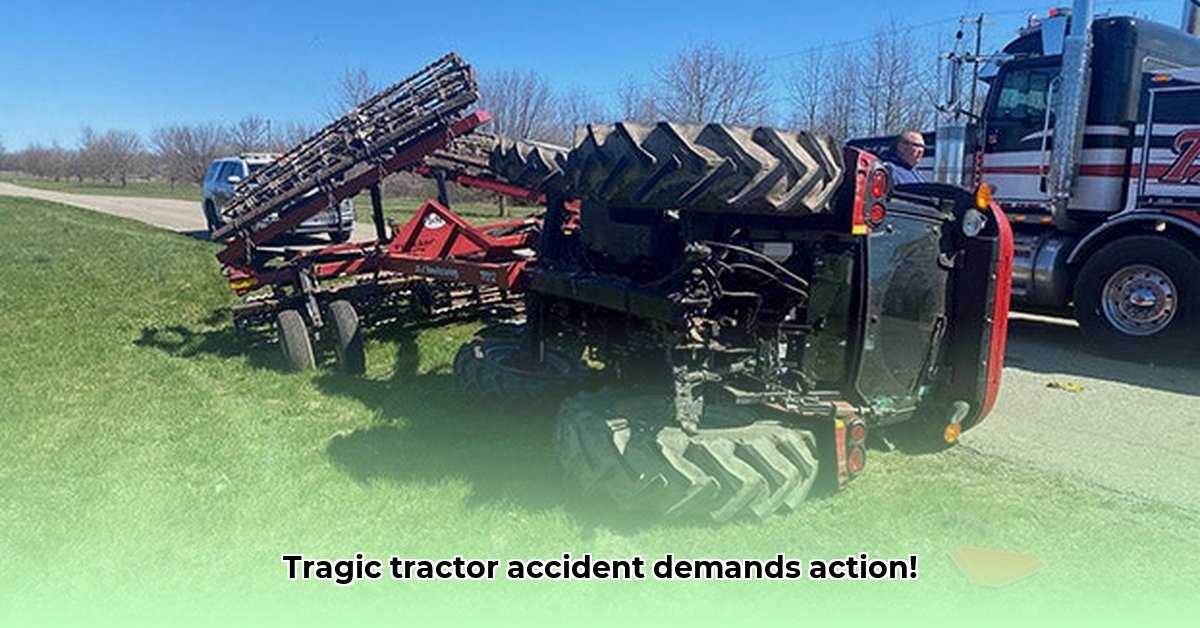
Farmer Killed in Tractor Accident: A Wake-Up Call for Farm Safety
Matthew Mathies, a dedicated farmer committed to sustainable agriculture, tragically lost his life in a tractor accident. His death profoundly impacted his family, friends, and the entire farming community. This isn't just a statistic; it's a devastating loss highlighting the critical need for improved farm safety. Matthew's story compels us to act decisively and prevent similar tragedies. Aren't the lives of our farmers worth prioritizing with improved safety measures? For more information on tractor safety, see this resource.
The Shocking Reality of Farm Accidents
Farm work carries significantly higher fatality rates than almost any other profession. The risk of death is approximately eight times greater than the national average across all occupations.1 Tractor rollovers represent a substantial portion of these fatal accidents, claiming countless lives each year. These aren't just numbers; they represent families torn apart and communities grieving. How many more lives must be lost before we address this urgent crisis?
Uncovering the Hidden Dangers on the Farm
Several factors contribute to these preventable deaths. Older tractors, frequently used on smaller, sustainable farms, often lack essential safety features. Imagine operating an older machine without a Rollover Protective Structure (ROPS) on a steep incline. It's a high-risk scenario. Inadequate training, common on smaller independent farms embracing sustainable practices, increases the risk considerably. Mechanical failures and unfamiliarity with new technologies further compound the dangers. We must act to protect those providing our food.
Breaking Down the Risks: A Closer Look
The following matrix details the significant hazards faced by farmers:
| Hazard | Probability | Severity | Overall Risk | Mitigation Strategies |
|---|---|---|---|---|
| Older Tractors (No ROPS) | Very Likely | Extremely High | Extremely High | Install ROPS, consider tractor replacement |
| Steep Slopes | Likely | High | High | Avoid steep slopes; use counterweights; implement proper grading |
| Insufficient Training | Very Likely | High | High | Mandatory safety courses; regular refresher training |
| Mechanical Malfunctions | Likely | Moderate | Moderate | Regular maintenance; prompt repairs; preventative maintenance schedules |
| Unfamiliar Technology | Likely | Moderate | Moderate | Thorough operator manuals; hands-on training; accessible tech support |
Taking Action: Immediate and Long-Term Strategies
A multifaceted approach involving farmers, agricultural organizations, government agencies, and equipment manufacturers is essential.
Short-Term Goals (Within One Year):
- Farmers: Install ROPS on tractors; participate in safety training; explore government funding for safety upgrades. (Efficacy: Improved safety ratings by up to 90% with ROPS installation).
- Agricultural Organizations: Develop safety guidelines; offer subsidized training; advocate for increased government funding for farm safety initiatives.
- Government Agencies: Increase funding for farm safety programs; strictly enforce existing regulations; consider stricter regulations where needed.
- Equipment Manufacturers: Design tractors with enhanced standard safety features; invest in research of cutting-edge safety technologies.
Long-Term Goals (3-5 Years):
- Farmers: Advocate for improved safety regulations; invest in advanced safety technologies; share safety best practices.
- Agricultural Organizations: Conduct thorough farm safety research; develop specialized safety technologies tailored for sustainable agriculture; promote technology adoption.
- Government Agencies: Implement mandatory safety inspections; develop comprehensive, adaptable safety standards; prioritize data collection and analysis to inform future policy.
- Equipment Manufacturers: Develop and market safety technologies specifically designed for sustainable agriculture; continuously improve tractor designs.
Addressing the Data Deficiency
Lack of comprehensive data is a major obstacle. We urgently need better data collection methods to fully understand the causes of these accidents and evaluate the effectiveness of prevention strategies. Improved data will lead to more targeted and effective solutions.
Learning from Successes and Sharing Best Practices
Studying successful safety initiatives is crucial. Sharing these successes, highlighting effective training programs, and showcasing advanced equipment designs will encourage broader adoption of life-saving measures.
The memory of Matthew Mathies and others lost to these preventable accidents should spur us to action. By working collaboratively, we can honor their lives and create a farming environment where safety is paramount. This isn't just about preventing future tragedies; it's about valuing and protecting the lives of those who work tirelessly to feed our communities.
Source: (Insert reputable source citing farm fatality statistics here - e.g., USDA, NIOSH) ↩